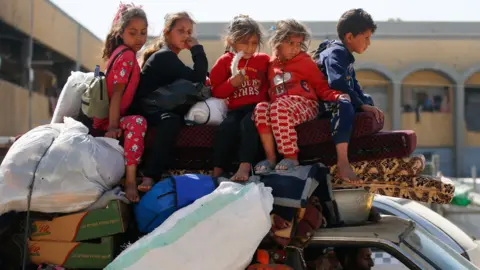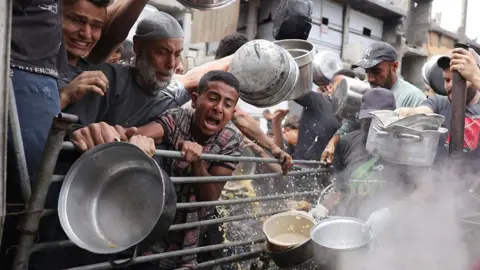BBC News
 Reuters
ReutersNearly 100 people, including children, were killed in a large -scale Israeli, air and sea attack launched early Friday in North Gaza, the civil defense managed by Hamas and the residents said.
The civil defense said that at least nine houses and tents sheltering civilians had been bombed overnight and that he had received dozens of trapped people.
Witnesses also reported smoke bombs, artillery bombings and Beit Lahia.
The Israeli army said it “operated to locate and dismantle terrorist infrastructure sites” in North Gaza and “eliminated several terrorists” during the last day.
This marks the largest assault on the ground on North Gaza since Israel resumed its offensive in March.
Basheer al-Ghandour, who fled Beit Lahia for Jabalia after the attack, told the people of the BBC when they suddenly slept “intense bombardments” overnight.
“It came from all sides-air strikes and warships. My brother’s house collapsed. There were 25 people inside,” he said.
He said 11 people had been injured and five killed, including his nieces, at the age of five and 18, and a 15 -year -old nephew. He and others tried to release parents from the rubble.
“My brother’s wife is always under the rubble-we have failed to save her. Due to the intensity of the bombing, we had to flee,” he said.
“We didn’t take anything with us – no furniture, no food, no flour. We have even left on foot.”
Another survivor, Yousf Salem, told journalists that he and his three children had “just escaped death”.
“An aerial strike struck the house of our neighbors-none of them survived,” he said.
He said the artillery shells started to strike near their house when they were trapped inside. When he tried to leave, a quadcopter drone opened fire, he said.
He made a second attempt under heavy bombing, he said. All the roads were blocked, but they managed to find a secondary road.
“We only escaped a few minutes before the Israeli tanks surround the area,” he said.
According to local residents, the attack started with smoke bombs dams, followed by intense artillery, nearby Israeli posts.
The tanks then started to move towards the Al-Salateen district in the west of Beit Lahia.
Witnesses reported that Israeli armored vehicles surrounded a school housing hundreds of displaced civilians.
Israeli aircraft abandoned the leaflets early Friday in several northern areas of Gaza calling residents to evacuate the areas immediately, which has feared that the Israel Defense forces (FDI) extended its military operation in one of the most densely populated regions of Gaza.
Evacuation orders have triggered the panic of families who have been moved several times since the start of the war. Many have nowhere to go.
“I swear I don’t know where we are going,” said Sana Marouf, who was fleeing with her family in a donkey cart in Gaza City.
“We do not have mattresses, blankets, food or water.”
She said she had seen people “torn apart” overnight. “It was a dark night. They bombed us tirelessly.”
 Reuters
ReutersThe North Gaza attack comes after Israeli air strikes killed more than 120 people, mainly in the south on Thursday.
On Friday, the FDIs said that it had reached more than 150 “terrorist targets” throughout Gaza during the last day, including anti -tank missiles, military structures and centers where groups planned to “carry out terrorist attacks against TSI troops”.
In the south of Gaza, the FDIs said they had dismantled Hamas structures and trees killed “several terrorists” who, according to Israel, had planned to plant an explosive device.
Although the powerful strikes on Friday night and reported by the ground troops west of Beit Lahia are important, this is not yet like the threatened military offensive of Israel.
The Israeli government has undertaken to intensify operations in Gaza and reoccupy the band indefinitely if Hamas has not accepted a temporary cease-fire proposal and the return of the remaining hostages at the end of the regional trip of President Donald Trump, which ended on Friday.
Although there was no sign of a breakthrough with the negotiation teams still in Doha, local media say that the Arab mediators have for more time giving a chance.
A ceasefire between Israel and Hamas agreed in January in January when Israel revived air strikes in Gaza in March.
Israel has also implemented a total blockade of humanitarian aid, including food, which has been largely condemned by the UN as well as European and Arab countries.
Israeli Defense Minister Israel Katz last month said the blockade was a “main pressure lever” to win Hamas and take out all hostages.
There is more and more evidence that the 10 -week blockade of Israel has an increasingly harmful humanitarian impact. Help organizations and residents say that the inhabitants of Gaza are now starving.
A recent report supported by the UN indicated that the whole population of Gaza – some 2.1 million people – is at a critical risk of famine.
The Israeli government insisted that there is no shortage of food in Gaza and that “real crisis is the looting and help of Hamas”.
 Getty images
Getty imagesIsrael and the United States have proposed to authorize and distribute aid through private companies – a plan rejected by the UN.
The deterioration situation in Gaza aroused concerns by the United States this week.
On the verge of his return flight since the Middle East, Trump said that the United States had to “help the Palestinians” and recognize that “many people are hungry”.
On Thursday, US Secretary of State Marco Rubio said the Trump administration was “troubled” by the humanitarian situation.
Israel launched a military campaign to destroy Hamas in response to the group’s cross -border attack on October 7, 2023, during which around 1,200 people were killed and 251 others were taken hostage.
At least 53,000 people have been killed in Gaza since then, according to the Ministry of Health managed by Hamas in the territory.
Fifty-eight hostages are still detained in Gaza, of which up to 23 are supposed to be alive.
Additional report by Alice Cuddy in Jerusalem



